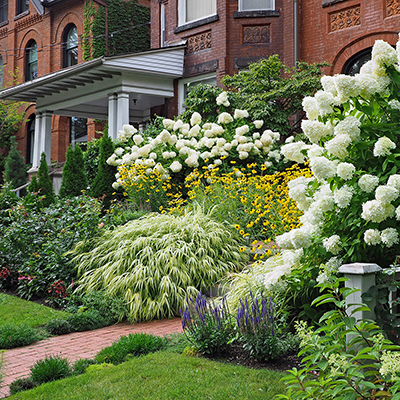How to Plant Spring Flowering Shrubs and Trees

Published May 14, 2024
Planting spring flowering trees and shrubs is a great way to add color and movement to your yard. After a long, cold winter, the bright blooms and foliage bring spring to your landscape.
Flowering trees and shrubs add value to your property, and invite birds and butterflies. Read on to learn everything you’ll need to know about planting spring flowering trees and shrubs in your landscape.
Difficulty:
Beginner
Duration:
2-4 hours
Table of Contents
Select a Site for Tree or Shrub
Check the Soil
Dig a Hole
Fill with Water and Drain
Plant Flowering Trees and Shrubs
Water Deeply
Select a Site for Tree or Shrub

The first step is to choose where you’re going to plant the trees or shrubs. Consider how sunny or shady the area is and how much space a mature plant will need. Research online and read plant tags in the Garden Center to find the right plant for your site.
Consider the mature size of the tree and shrubs when planning your project. Experts recommend keeping small shrubs two feet from foundations, allowing four to five feet for medium size shrubs, and seven to eight feet for large shrubs. Keep in mind that shrubs can take three to six years to reach their mature size. Quick-growing trees reach mature size in about 10 years.
The best time of year to plant trees and shrubs is when the weather is cool and wet. This is why experts recommend fall planting for trees and shrubs. The next best time to plant is in late winter and early spring, as soon as the soil is workable.
Flowering trees available in the Garden Center and online include:
- Chaste tree (vitex)
- Crabapple
- Crepe myrtle
- Dogwood
- Eastern redbud
- Flowering cherry
- Flowering peach
- Flowering plum
- Golden chain
- Magnolia
Flowering shrubs available online and in the Garden Center include:
- Abelia
- Azalea
- Cherry laurel
- Dipladenia
- Gardenia
- Hibiscus
- Hydrangea
- Loropetalum
- Rhododendron
- Spirea
- Sweetspire
Note that selection varies by season and region.
Check the Soil

Give your new tree or shrub the best start with the best soil. Make sure the soil is moist, but not wet, before you dig. Wet soil becomes compacted, making it tough for roots to penetrate. Grab a handful of soil, squeeze it into a ball, and release. Moist soil will crumble into pieces; wet soil will stay in a ball.
Tip: Before you invest in trees and shrubs, test your soil. You can get a soil test kit from your local Extension office or the Garden Center. Amend your soil with recommendations based on the soil test.
Dig a Hole

Once you’ve tested and amended the soil, it’s time to dig the hole. Use a garden shovel to dig a hole that’s three to four times as wide as your plant’s container to make it easy for the roots to grow outward. The hole should be no deeper than the height of the container. Dig a hole with an irregularly-shaped edge, rather than a round one, to help encourage your plant’s roots to penetrate into the native soil around it.
Fill with Water and Drain

Before you plant, fill the hole with water and let it drain. This lets you measure how good the drainage the soil in your area has. If the water drains slower than one inch per hour, that can be a sign that the soil may have poor drainage.
You can amend the soil with compost to improve water drainage.
Tip: Watering your hole before planting also prevents the dry soil around your plant from taking the water away from the root ball when you first water it.
Plant Flowering Trees and Shrubs

Next, with your planting hole ready, you can plant the flowering trees and shrubs.
- Ease the plant out of the pot. If the roots were growing in a circle in the pot, gently spread them out.
- Set the plant in the hole so that the place where the trunk meets the roots is at the soil line, not too high and not too deep.
- Replace half of the soil and lightly pat it down, making sure to eliminate air pockets.
- Water and then fill the hole the rest of the way, gently compacting as you go.
- Build a shallow saucer of soil around the perimeter of the hole like a moat to hold water.
Water Deeply

Once your plants are in the ground, water gently but deeply using a watering can or garden hose. A strong jet of water can wash away the soil. Watering cans are a great way to make sure you’re always watering gently. For the first two months after planting, water at least once a week if there is no rain. Water evenly around the plant to promote a balanced, well-developed root system, and avoid getting leaves wet to help prevent disease.
Tip: The best times to water your plants are in the early morning or late in the evening. This way, the water doesn’t evaporate as quickly as it does during the day’s heat.
Add Mulch

After planting the tree or shrub, mulch around the plant. Keep mulch 2 to 3 inches away from the trunks of trees and shrubs. Do not mound like a volcano.
Adding mulch around your plants has many benefits. Mulch protects your plants by shielding them from extreme temperatures, keeps weeds away, and slows the evaporation of water from the soil.
After a long winter, spring flowering trees and shrubs bring life and beauty back into your yard. When you plan out your space and use just a few simple tools, you can add curb appeal and value to your property with these colorful plants. The Home Depot delivers online orders when and where you need them.



























